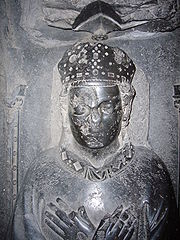
Guy of Avesnes
Encyclopedia

Utrecht (city)
Utrecht city and municipality is the capital and most populous city of the Dutch province of Utrecht. It is located in the eastern corner of the Randstad conurbation, and is the fourth largest city of the Netherlands with a population of 312,634 on 1 Jan 2011.Utrecht's ancient city centre features...
) was Bishop of Utrecht
Roman Catholic Archdiocese of Utrecht
The Archdiocese of Utrecht is an archdiocese of the Catholic Church in the Netherlands. The archdiocese is the metropolitan for 6 suffragans, the dioceses of Breda, Groningen-Leeuwarden, Haarlem-Amsterdam, Roermond, Rotterdam, and 's-Hertogenbosch....
from 1301 to 1317.
Family
He was descended from an important Hainaut family, the House of AvesnesHouse of Avesnes
The Avesnes family played an important role during the Middle Ages. The family has its roots in the small village Avesnes-sur-Helpe, in the north of France....
. He was the brother of John II
John II, Count of Holland
John II of Avesnes was the oldest son of John I of Avesnes and Adelaide of Holland.-History:John II was Count of Hainaut from 1280 to his death, succeeding his grandmother, Margaret II...
, Count of Hainaut and Count of Holland
Count of Holland
The Counts of Holland ruled over the County of Holland in the Low Countries between the 10th and the 16th century.-House of Holland:The first count of Holland, Dirk I, was the son or foster-son of Gerolf, Count in Frisia...
, and their parents were John I of Avesnes
John I of Avesnes
John I of Avesnes was the count of Hainaut from 1246 to his death. Born in Houffalize, he was the eldest son of Margaret II of Flanders by her first husband, Bouchard IV of Avesnes...
and Adelaide of Holland
Adelaide of Holland
Adelaide of Holland or Aleide van Holland was a daughter of Floris IV, Count of Holland and Matilda of Brabant. She was also a sister of William II, Count of Holland and King of Germany...
.
Life
It was John II who ensured Guy's appointment as bishop of Utrecht in 1301, instead of Adolf II van WaldeckAdolf II of Waldeck
Adolf II van Waldeck was count of Waldeck from 1270 to 1276 and prince bishop of Liège from 1301 to 1302.-Life:Adolf was a son of count Hendrik III of Waldeck and of Mechthild of Cuyk-Arnsberg. In 1270 he followed his grandfather Adolf I of Waldeck as count of Waldeck...
, and he was consecrated bishop by the archbishop of Cologne during the following year. He brought about a reconciliation between the Lichtenbergers and the Fresingen. However, in 1304 he weakened his brother John's position by leading an offensive of Flemish troops which then occupied Holland and the Sticht. Guy was then captured at the Battle of Duiveland on 20 March 1304. In Guy's absence, the Fresingen seized power in Utrecht with the support of the guilds, whose privileges they fixed in the "Gildenbrief" of 9 May 1304. On 14 September 1305, the guilds regime had to capitulate to bishop Guy (who had been released), but from then on the city retained a high degree of autonomy. However, it took until 1309 before the king fully recognised the bishop as Utrecht's secular lord.
In 1311, Guy took his place at the first Council of Vienne
Council of Vienne
The Council of Vienne was the fifteenth Ecumenical Council of the Roman Catholic Church that met between 1311 and 1312 in Vienne. Its principal act was to withdraw papal support for the Knights Templar on the instigation of Philip IV of France.-Background:...
, and from that date on he was frequently abroad. He knew well that a compromise had to be made between the various parties in the Sticht and in Utrecht itself, and so took up a middle-of-the-road position. He personally managed the possessions of the lordships of Aemstel
Van Aemstel family
The van Aemstel or van Amstel dynasty was a major lordly dynasty in medieval Holland, which held the heerlijkheid of Amstelland , which it governed in the name of the bishop of Utrecht and the count of Holland....
and of Woerden
Woerden
Woerden is a municipality and a city in the central Netherlands. Due to its central location between Amsterdam, Rotterdam, The Hague and Utrecht, and the fact that it has excellent rail and road connections to those cities, it is a popular town for commuters who work in those cities.-Population...
, and as such granted town privileges
Town privileges
Town privileges or city rights were important features of European towns during most of the second millennium.Judicially, a town was distinguished from the surrounding land by means of a charter from the ruling monarch that defined its privileges and laws. Common privileges were related to trading...
to Amsterdam
Amsterdam
Amsterdam is the largest city and the capital of the Netherlands. The current position of Amsterdam as capital city of the Kingdom of the Netherlands is governed by the constitution of August 24, 1815 and its successors. Amsterdam has a population of 783,364 within city limits, an urban population...
in 1306. After his death these lordships definitively devolved to the count of Holland. He was buried in Utrecht Cathedral
Cathedral of Saint Martin, Utrecht
St. Martin's Cathedral, Utrecht, or Dom Church was the cathedral of the diocese of Utrecht during the Middle Ages. Once the Netherland's largest church, dedicated to Saint Martin of Tours, it is one of the country's two pre-Reformation cathedrals, along with the cathedral in Middleburg, Province...
and his tomb, damaged during the iconoclasm in the 16th century, still survives.
Children
He had two daughters:- Maria of Avesnes, married Arnoud van Amstel van IJsselstein
- Aleid of Avesnes, married Otto van Asperen van Heuckelom

